Easter – The Celebration of Resurrection, divine miracle, light and love
by Melania Radu
Motto: „Then, I bid farewell to them,
Explaining to them that from then on they will no longer see Me in my body,
If they were to still remain with Me in spirit, every moment.”
– The Great Gospel of John by Jakob Lorber
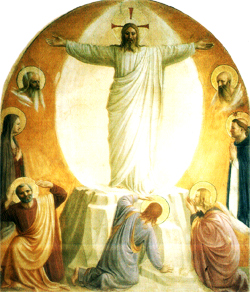 Easter is the most important yearly annual holiday. It is a commemoration of the fundamental event of Christianity – the Resurrection of Jesus Christ, the Son of God, on the third day after He was crucified, on the Good Friday. The beginning of Easter marks the beginning of the ecclesiastic year. This holiday lasts three days and it begins on the Sunday after the first Full Moon after the spring equinox, according to the Council of Nicaea which took place in 325 AD.
Easter is the most important yearly annual holiday. It is a commemoration of the fundamental event of Christianity – the Resurrection of Jesus Christ, the Son of God, on the third day after He was crucified, on the Good Friday. The beginning of Easter marks the beginning of the ecclesiastic year. This holiday lasts three days and it begins on the Sunday after the first Full Moon after the spring equinox, according to the Council of Nicaea which took place in 325 AD.
The special charm that comes with Easter is given both by the spiritual significance (“…My resurrection will also be a resurrection for all those who follow Me.” – The Great Gospel of John by Jakob Lorber) as well as by traditions (the painted eggs, the traditional meal, the Saturday night church service with the act of receiving the light). Easter is a moment of peace, of inner focusing, reconcilement and joy.
The miracle of divine light
A miracle that takes place regularly each year, awaited anxiously by people and yet leaving everyone in awe, is the apparition of the divine light at the Holy Tomb in Jerusalem during the Resurrection night of Orthodox Easter. This is the gift that Jesus gives us, thus making us remember of the brilliant light that filled his tomb during His Resurrection. It is his way of telling us that he is always with us.
This ethereal blue colored fire that can be touched without getting burned is awaited with all the lights out. Then, the fire occurs in a supernatural way from the Holy Tomb and the candle which was previously placed there on purpose miraculously lights up. Then the Orthodox Patriarch lights up the two groups of 33 candles each and he begins to share the Holy Light with the thousands of pilgrims who are anxiously waiting. The living fire acts by itself, lighting up the candles at the church door and the candles of some of the pilgrims.
This event happens every year before thousands of eye-witnesses. It cannot be denied by anyone. This is why its effect is extremely powerful and it increases people’s faith in God.
The Holy Week
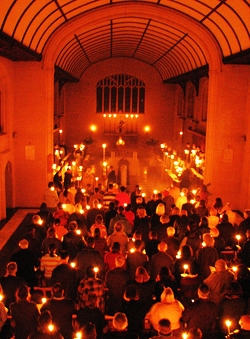 The last week of the Easter Fasting, also known as the Passion Week is an important time of inner focusing and commemoration. It is a time when people remember the Passion of Jesus, the tortures he was subjected to, from His treason by Judas and up to his crucifixion on the Golgotha, His death and Resurrection.
The last week of the Easter Fasting, also known as the Passion Week is an important time of inner focusing and commemoration. It is a time when people remember the Passion of Jesus, the tortures he was subjected to, from His treason by Judas and up to his crucifixion on the Golgotha, His death and Resurrection.
The week begins with Palm Sunday, the day in which Jesus Christ entered Jerusalem and it ends with the Easter Sunday, the day of His Resurrection. Wednesday is the day in which Judas betrayed him and Friday is the day in which he was crucified. This is why these two days are now fasting days all throughout the year. Thursday is the day in which Jesus washed the feet of his apostles, it is the day of the Last Supper, it is the day of the prayer in the Gethsemane garden and the day of his apprehension by those who wanted him dead.
“Great pride can only be annihilated through the deepest humbleness. This is why, it is necessary that I go through all this suffering. But do not be afraid, for I shall not remain in my tomb, I will not dissolve, but I will resurrect on the third day and I shall come to you again, just as I do now! Only this will be the greatest and truest confession of My divine mission for your souls and it will fully boost your faith.” – The Great Gospel of John by Jakob Lorber
“This will be a very upsetting judgment for these malicious and stubborn people, and for My people, this will be the culmination of My love, while My resurrection will always be a resurrection for all those who follow Me.” – The Great Gospel of John by Jakob Lorber
The celebration of joy
„…such an act, no matter how frightening it might seem for the human eye, is still necessary, so that in time, all the creatures would come back to the divine, pure, free and independent life…” – The Great Gospel of John by Jakob Lorber
The resurrection of Jesus Christ symbolizes the rehabilitation of the connection between the human being and its Creator. Its celebration, year by year, leads to the awakening of the state of aspiration of becoming one with God, to the transfiguration of earthen life into a life impregnated by the presence of God. This is why Easter is a celebration of joy, a joy similar to the joy that the apostles experienced upon seeing Jesus resurrected. And the salute used on this occasion is a mere expression of this joy: “Christ is risen! He is risen indeed!”
Popular traditions
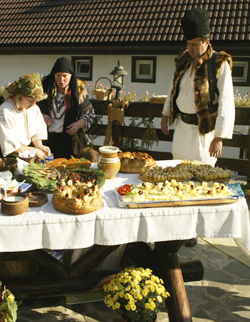 Similar to other Christian holidays, Easter comes with many popular customs which originate in ancient traditions (considered pagan by many today) and beliefs and superstitions related to the cycle of seasons and household works.
Similar to other Christian holidays, Easter comes with many popular customs which originate in ancient traditions (considered pagan by many today) and beliefs and superstitions related to the cycle of seasons and household works.
On the Good Friday, it is a custom to take some flowers to the church, for Jesus. During the service it is a custom to pass three times under the table as a symbol of the difficulties Jesus had when carrying his cross. On this day, which is also known as the Dry Friday, people usually fast. It is said that if it rains on this day, the year will be fruitful and abundant, and if it doesn’t rain, it will be a dry year. Another custom says that he who will bathe in cold water three times, as John the Baptist used to baptize in the river Jordan, will be healthy all year long.
On the Holy Saturday, they prepare the Easter bread and the cake which will later be taken to church to be consecrated in the Easter eve. In the evening, everyone goes to church to take part in the Resurrection service, to be given the light, to have a taste from the traditional Holy bread and wine, and to take a few of the consecrated flowers from the flowers that have been brought to church on the Good Friday. On Saturday afternoon, the 40 day fasting ends and the bells start tolling again. The most important moment of the day is the consecration of the baptizing water in church. It is said that the first person to be baptized with this “new” water will have good luck all throughout their lives.
On Sunday there is a custom that people wear new clothes as a sign of renewing the body and soul. In the morning, people prepare a kettle of cold water, an egg and a silver coin. Whoever washes in this water will have rosy cheeks, like the egg, and will life a rich life.
During the Easter night, people attending the church service carry a candle with them which they will then light from the light brought by the priest on the light of the Holy Altar. This candle is the symbol of Resurrection, of the triumph of life over death, of divine light over the darkness of ignorance. Some people even keep the candle stub and they light it during the year when encountering problems throughout the year.
A common belief is that the gates of heaven are open for one week after the night of Resurrection. This way, the souls of those who are departed during the Lighted Week will surely end up in heaven.
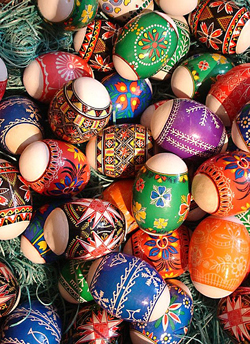 Red eggs are a symbol for the tomb of Jesus. This tomb opened upon His Resurrection. This is why when knocking the eggs and breaking them, people say: “Christ is risen! He is risen indeed!” These expressions can be used as forms of salute for forty days, until the Rise of the Lord. There is a belief according to which those who knock eggs on Easter will find each other after death. The red on the eggs symbolizes the blood of Christ. In some areas it is a custom to paint eggs. There are many names for these painted eggs, which differ from one area to another.
Red eggs are a symbol for the tomb of Jesus. This tomb opened upon His Resurrection. This is why when knocking the eggs and breaking them, people say: “Christ is risen! He is risen indeed!” These expressions can be used as forms of salute for forty days, until the Rise of the Lord. There is a belief according to which those who knock eggs on Easter will find each other after death. The red on the eggs symbolizes the blood of Christ. In some areas it is a custom to paint eggs. There are many names for these painted eggs, which differ from one area to another.
There are also many legends about the red eggs. In some stories, the Mother of Christ is either throwing red eggs behind her to confuse the people chasing her, or she turns the stones they are throwing at her into red eggs. Another legend says that when Christ was crucified, Mary placed a basket of eggs underneath the cross so that she would soften up the soldiers and the eggs turn red with the blood of Christ. It is also said that when Jesus was beaten up with stones, the stones turned into red eggs upon touching him. Another story says that the news of the Resurrection of Christ was regarded with suspicion by some: a woman who sold eggs in the market said that she will believe this when her eggs would turn red. And her eggs did turn red immediately.
Eggs are also a symbol of rejuvenation, of spring. Adorned or colored eggs were given as a gift in spring, as a symbol of rebirth, even since the pre-Christian era. In ancient Egypt, the egg was a symbol of the covenant of life and it represented the coffin or the death chamber. In Romanian popular tradition, Easter eggs are endowed with miraculous powers: they can heal diseases and they have protective abilities.
Easter bread is a cake specific to Easter, round shaped, with a cross in the middle. It’s usually made with cottage cheese and the dough is intertwined on the sides. When placed in the oven, women make a cross with the peel on the sides of the oven. There is a legend about its origin which says that, while preaching together with the apostles, Jesus was hosted in the house of a generous man. When they left, he put bread in their bags for the road. The apostles asked Jesus about the date of Easter and he said that Easter will be when they will find bread in their bags. They looked inside their bags and they found the bread. This is where the custom of Easter bread came from.
Other customs:
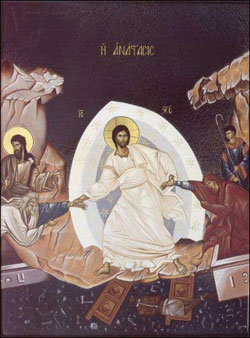 * The first Christians would call the first week after Easter “The White Week”, because those who were baptized on that week would wear white clothes, as a symbol of renewal.
* The first Christians would call the first week after Easter “The White Week”, because those who were baptized on that week would wear white clothes, as a symbol of renewal.
* The Austrians adorn the eggs with leaves or flowers, then they put them in paint tied inside a sock, thus imprinting the pattern of the leaf on the egg. Romanians also use parsley or lovage leaves to decorate eggs.
* On the second day of Easter, girls from Transylvania are sprinkled with perfume.
* The polish also paint their eggs just as the Romanians do, this custom is known by the name of “pisanski” (from the verb pisac, which means “to write”).
* In the Easter night, Bulgarians knock an egg against the wall of the church.
* In Italy, the priests bless all the Easter eggs which are placed in the center of the Sunday dining table.
* The Germans have the custom of gathering all the Christmas trees together and lighting them on fire in a great “Easter Fire”, a symbol of the passing of winter and the coming of spring.
* In Spain, the “Semana Santa” (The Great Week) is celebrated through processions with adorned chariots which are a reminder of the festivals prior to Christianity.
* On the second day of Easter, the Welsh climb the mountains in order to greet the first rays of the Sun, a harbinger of Resurrection.
* In Mexico, people organize shows during the “Semana Santa” (The Great Week) whose subject is the passion of Jesus Christ, the actors wearing the garments used 2000 years ago.
yogaesoteric
April 2015
Also available in:
 Română
Română
